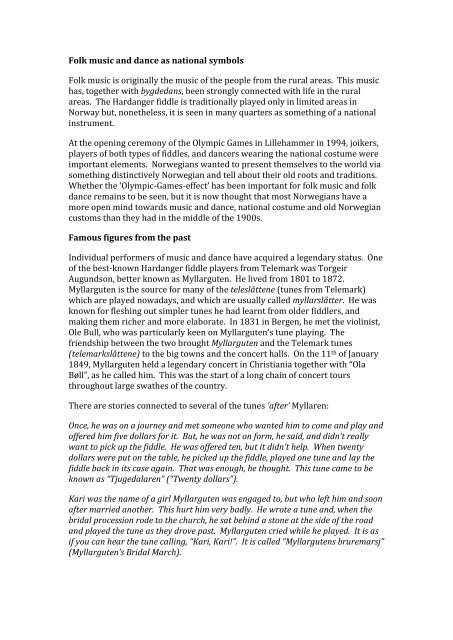The fiddle traditions The violin comes to Norway It is believed that ...
The fiddle traditions The violin comes to Norway It is believed that ...
The fiddle traditions The violin comes to Norway It is believed that ...
Create successful ePaper yourself
Turn your PDF publications into a flip-book with our unique Google optimized e-Paper software.
Folk music and dance as national symbolsFolk music <strong>is</strong> originally the music of the people from the rural areas. Th<strong>is</strong> musichas, <strong>to</strong>gether with bygdedans, been strongly connected with life in the ruralareas. <strong>The</strong> Hardanger <strong>fiddle</strong> <strong>is</strong> traditionally played only in limited areas in<strong>Norway</strong> but, nonetheless, it <strong>is</strong> seen in many quarters as something of a nationalinstrument.At the opening ceremony of the Olympic Games in Lillehammer in 1994, joikers,players of both types of <strong>fiddle</strong>s, and dancers wearing the national costume wereimportant elements. Norwegians wanted <strong>to</strong> present themselves <strong>to</strong> the world viasomething d<strong>is</strong>tinctively Norwegian and tell about their old roots and <strong>traditions</strong>.Whether the ‘Olympic-Games-effect’ has been important for folk music and folkdance remains <strong>to</strong> be seen, but it <strong>is</strong> now thought <strong>that</strong> most Norwegians have amore open mind <strong>to</strong>wards music and dance, national costume and old Norwegiancus<strong>to</strong>ms than they had in the middle of the 1900s.Famous figures from the pastIndividual performers of music and dance have acquired a legendary status. Oneof the best-known Hardanger <strong>fiddle</strong> players from Telemark was TorgeirAugundson, better known as Myllarguten. He lived from 1801 <strong>to</strong> 1872.Myllarguten <strong>is</strong> the source for many of the teleslåttene (tunes from Telemark)which are played nowadays, and which are usually called myllarslåtter. He wasknown for fleshing out simpler tunes he had learnt from older <strong>fiddle</strong>rs, andmaking them richer and more elaborate. In 1831 in Bergen, he met the <strong>violin</strong><strong>is</strong>t,Ole Bull, who was particularly keen on Myllarguten’s tune playing. <strong>The</strong>friendship between the two brought Myllarguten and the Telemark tunes(telemarkslåttene) <strong>to</strong> the big <strong>to</strong>wns and the concert halls. On the 11 th of January1849, Myllarguten held a legendary concert in Chr<strong>is</strong>tiania <strong>to</strong>gether with “OlaBøll”, as he called him. Th<strong>is</strong> was the start of a long chain of concert <strong>to</strong>ursthroughout large swathes of the country.<strong>The</strong>re are s<strong>to</strong>ries connected <strong>to</strong> several of the tunes ‘after’ Myllaren:Once, he was on a journey and met someone who wanted him <strong>to</strong> come and play andoffered him five dollars for it. But, he was not on form, he said, and didn’t reallywant <strong>to</strong> pick up the <strong>fiddle</strong>. He was offered ten, but it didn’t help. When twentydollars were put on the table, he picked up the <strong>fiddle</strong>, played one tune and lay the<strong>fiddle</strong> back in its case again. That was enough, he thought. Th<strong>is</strong> tune came <strong>to</strong> beknown as “Tjugedalaren” (“Twenty dollars”).Kari was the name of a girl Myllarguten was engaged <strong>to</strong>, but who left him and soonafter married another. Th<strong>is</strong> hurt him very badly. He wrote a tune and, when thebridal procession rode <strong>to</strong> the church, he sat behind a s<strong>to</strong>ne at the side of the roadand played the tune as they drove past. Myllarguten cried while he played. <strong>It</strong> <strong>is</strong> asif you can hear the tune calling, “Kari, Kari!”. <strong>It</strong> <strong>is</strong> called “Myllargutens bruremarsj”(Myllarguten’s Bridal March).


